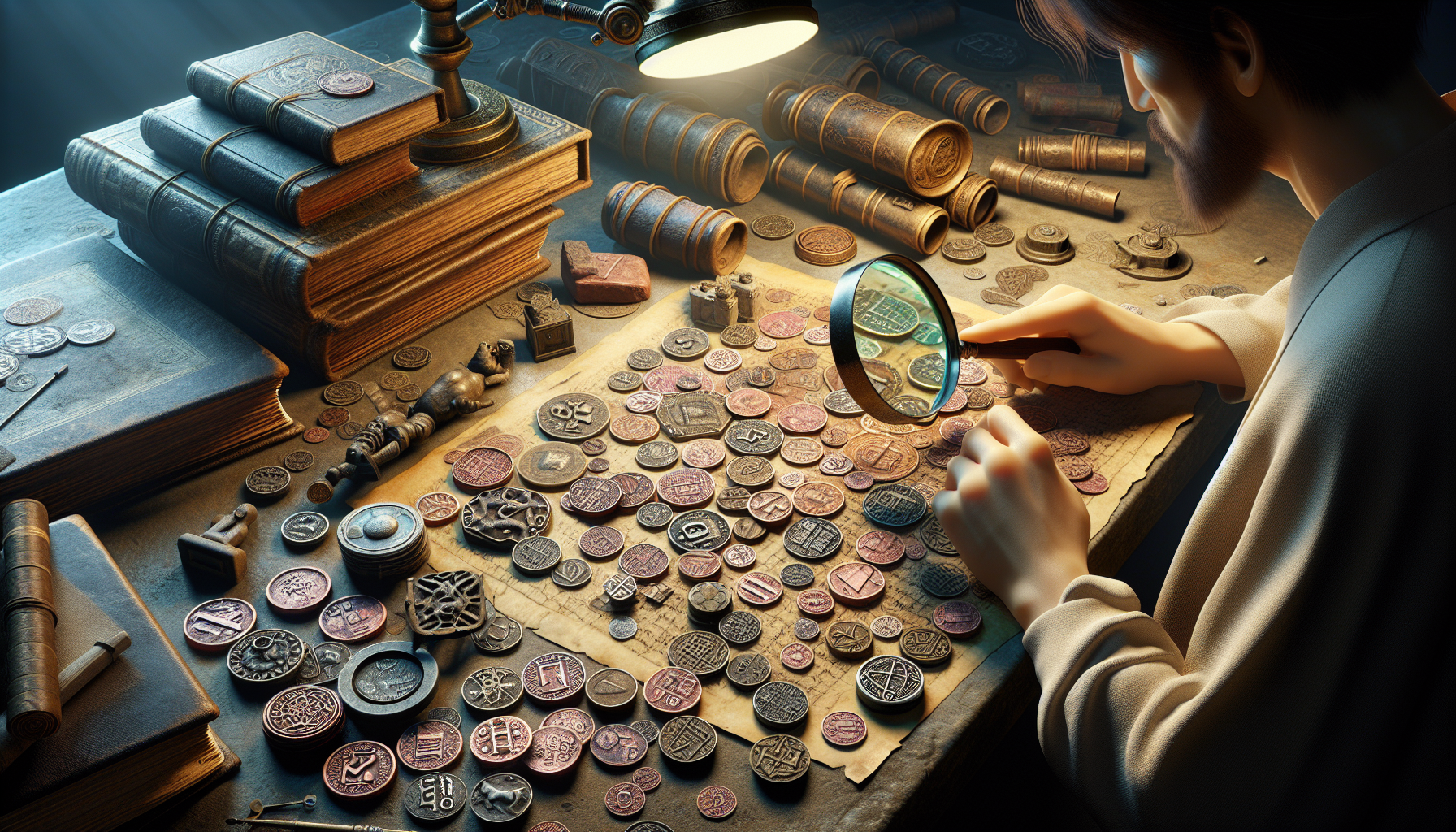Throughout the annals of human history, artifacts have served as the silent witnesses to the evolution of civilizations, encapsulating stories, beliefs, and innovations in their tangible forms. Among these relics, coins and stamps hold a unique place. These small yet powerful items not only facilitated trade and communication but also acted as canvases for conveying messages, both overt and cryptic. The intricate designs and enigmatic codes embedded within them offer a fascinating glimpse into the societal norms, political shifts, and cultural milestones of their respective eras. In this exploration, we delve into the world of ancient codes found on coins and stamps, seeking to unravel the secrets they hold and to understand the mysteries of our shared past.
Coins, often seen as mere instruments of commerce, have been meticulously crafted to serve purposes far beyond their economic utility. From the imagery of deities and rulers to symbols of power and prosperity, these metallic discs are embedded with messages intended for both contemporary and future audiences. The codes on coins can reveal much about the political landscape, economic conditions, and cultural values of the time. For instance, Roman coins might feature inscriptions and iconography that propagate the might and divine right of an emperor, while coins from ancient Greece might showcase the artistic prowess and mythological beliefs that characterized their society. By examining these details, historians and numismatists can piece together narratives that shed light on the complexities of ancient civilizations.
Stamps, though a more modern invention compared to coins, carry their own set of enigmatic codes and historical significance. Born out of a need to streamline communication, stamps rapidly evolved into miniature works of art and potent symbols of national identity. Beyond their primary function of denoting postage, stamps have been used to commemorate significant events, honor influential figures, and convey political messages. The designs, colors, and even the placement of elements on stamps can carry hidden meanings or messages intended to be understood by a select few. As we decipher these codes, we gain insight into the zeitgeist of different eras and the subtle ways in which governments and societies communicated their values and aspirations to the world.
In the following sections, we will embark on a journey through time, examining some of the most intriguing codes found on coins and stamps from various cultures and periods. We will explore the methods used by historians and enthusiasts to decode these messages and the impact of these discoveries on our understanding of history. Additionally, we will consider the modern implications of these ancient codes, pondering what they reveal about human nature and the timeless desire to communicate complex ideas in creative and enduring ways. Join us as we unlock the secrets of the past, one coin and stamp at a time. 🕵️♂️🔍
The Intriguing World of Ancient Codes
Since the dawn of civilization, humans have been captivated by the mysteries locked within ancient codes. Coins and stamps, often overlooked in everyday life, hold within them a wealth of historical information encoded in their designs, symbols, and inscriptions. These small artifacts serve as windows into the past, offering glimpses into the economic, political, and cultural landscapes of bygone eras.
The study of these ancient codes is not just an exercise in historical curiosity. It is a multidisciplinary endeavor, drawing from fields as diverse as numismatics, philately, archaeology, and cryptography. Each field brings its own methodologies and insights, contributing to a more comprehensive understanding of these enigmatic symbols. For instance, numismatists meticulously analyze coins to uncover the socio-economic context of the societies that produced them, while philatelists focus on stamps as a means of exploring global communication and postal history.
Deciphering the Symbols on Coins
Coins have been used as a medium of exchange for millennia, but they are also rich sources of historical and cultural information. Every element on a coin—from its imagery to its inscriptions—has been carefully chosen to convey specific messages about power, religion, or ideology.
The process of deciphering these symbols involves a detailed analysis of the iconography and inscriptions. For example, the depiction of rulers on coins was a common practice, serving not only as a testament to their reign but also as a means of legitimizing their authority. These images were often accompanied by inscriptions that could include titles, mottos, or dates, each carrying its own significance.
In addition to rulers, coins often feature symbols related to the state religion, military victories, or famous landmarks. Each of these elements provides insights into the values and priorities of the society that minted the coin. By examining these aspects, historians and numismatists can reconstruct the narratives of ancient civilizations, offering a window into their worldviews and belief systems.
Moreover, technological advances in imaging and analysis have greatly enhanced our ability to study these ancient artifacts. Techniques such as high-resolution photography, digital modeling, and spectroscopy allow researchers to uncover details that were previously inaccessible, shedding new light on the mysteries of the past.
The Enigmatic Art of Stamps
Stamps, much like coins, are small but potent carriers of information. Originally intended to facilitate the postal service, stamps quickly evolved into a form of art and communication, reflecting the identity and aspirations of nations. Each stamp tells a story, whether it be of a historical event, a national hero, or a cultural symbol.
Philatelists, or stamp collectors, have long recognized the value of stamps as historical documents. The process of analyzing stamps involves examining their design, color, and inscriptions, as well as their context within the broader postal system. Through this analysis, philatelists can glean insights into the social, political, and technological developments of the time.
Stamps are also unique in that they often commemorate specific events or individuals, providing a snapshot of the values and priorities of a nation at a given moment in time. These commemorations can range from political milestones to cultural achievements, each offering a unique perspective on history.
The digital age has further expanded the potential of stamp analysis. Online databases and digitization projects have made it easier than ever for researchers to access and compare stamps from around the world. This increased accessibility not only facilitates research but also enhances public appreciation and understanding of these miniature masterpieces.
Comparing Coins and Stamps
While both coins and stamps serve as historical documents, they each offer distinct perspectives and insights. The table below highlights some of the key differences and similarities between these two mediums:
| Aspect | Coins | Stamps |
|---|---|---|
| Primary Function | Medium of exchange, store of value | Facilitate postal communication |
| Common Themes | Rulers, religious symbols, military victories | Historical events, cultural symbols, national heroes |
| Analytical Focus | Numismatics, iconography, inscriptions | Philately, design, color, inscriptions |
| Technological Impact | Imaging, digital modeling, spectroscopy | Online databases, digitization projects |
By exploring these differences, researchers can gain a more holistic understanding of the past, piecing together the stories that have shaped our world.
Modern Techniques in Deciphering Ancient Codes
Advancements in technology have revolutionized the way we study ancient codes on coins and stamps. High-resolution imaging, for instance, allows us to capture even the most minute details of these artifacts, revealing insights that were previously invisible to the naked eye. This technology is especially useful for studying worn or damaged pieces, where traditional methods may fall short.
Another groundbreaking technique is 3D digital modeling, which enables researchers to create detailed virtual replicas of coins and stamps. These models can be manipulated and analyzed in ways that physical objects cannot, providing a new dimension to the study of these ancient codes. This technology also facilitates collaboration among researchers, as digital models can be easily shared and studied from anywhere in the world.
In addition to imaging technologies, analytical techniques such as spectroscopy have also proven invaluable. By analyzing the chemical composition of coins, for example, researchers can determine the sources of the metals used, shedding light on trade routes and economic networks of the past. This information can also help identify forgeries and understand the technological capabilities of ancient societies.
The Role of Collaboration and Crowdsourcing
As the study of ancient codes becomes increasingly interdisciplinary, collaboration among experts from various fields has become more crucial than ever. Numismatists, philatelists, archaeologists, historians, and technologists are working together to piece together the complex puzzles these artifacts present.
Crowdsourcing has also emerged as a valuable tool in this endeavor. Platforms that allow the public to contribute to the study of coins and stamps have led to the discovery of new insights and the identification of previously unknown pieces. This democratization of research not only accelerates the pace of discovery but also fosters a broader appreciation for these historical treasures.
To gain a better understanding of how modern technology aids in the study of ancient codes, consider watching the informative video below: “Decoding History: How Technology Unravels Ancient Mysteries” from the Science Channel.
Conclusion
Uncovering the mysteries embedded in ancient codes on coins and stamps is not merely an academic endeavor but a thrilling journey into the past, offering profound insights into the cultural, economic, and political landscapes of bygone eras. This exploration has allowed us to piece together narratives that have long been shrouded in mystery, and through the meticulous work of historians, archaeologists, and numismatists, we have been able to illuminate the rich tapestry of history that these artifacts represent.
Throughout this article, we delved into the fascinating world of coins and stamps, tracing their evolution from simple tokens of exchange and communication to complex carriers of hidden messages. We explored the origins and significance of these codes, examining how they have been used by ancient civilizations to convey power, commemorate significant events, and assert identity and authority. By understanding the contexts in which these artifacts were produced and circulated, we gain invaluable perspectives on the societies that created them.
One of the most captivating aspects of this study is the diversity of codes and symbols employed across different cultures and epochs. From the intricate depictions on Roman coins to the elaborate engravings on medieval stamps, each element serves as a testament to the creativity and ingenuity of its creators. These artifacts not only reveal the artistic and technical prowess of their time but also offer clues to the values, beliefs, and priorities of the people who used them.
The article highlighted several key methodologies employed in the deciphering of ancient codes, such as iconographic analysis, linguistic studies, and technological advancements like digital imaging and spectroscopy. These tools have empowered researchers to uncover layers of information previously thought inaccessible, opening up new avenues for historical inquiry and interpretation.
Moreover, the importance of interdisciplinary collaboration cannot be overstated. By bringing together experts from various fields, including history, archaeology, linguistics, and computer science, we are able to construct a more comprehensive understanding of the past. This collaborative approach not only enhances our ability to decode ancient symbols but also fosters innovation and cross-pollination of ideas, enriching the study of history as a whole.
The implications of uncovering ancient codes extend beyond academic interest. In a world where cultural heritage is increasingly threatened, these artifacts serve as crucial links to our shared human past, reminding us of the interconnectedness of civilizations. They urge us to preserve and protect our cultural treasures, ensuring that future generations can continue to learn from and be inspired by the achievements of their ancestors.
The process of deciphering these codes also encourages us to reflect on the nature of communication itself. As we unravel the messages encoded in coins and stamps, we are reminded of the enduring power of symbols and the ways in which they transcend time and language to convey complex ideas and emotions. This understanding can inform our contemporary practices, encouraging us to consider the symbols and messages we create today and their potential impact on future generations.
As we conclude our exploration of ancient codes on coins and stamps, it is essential to acknowledge the ongoing nature of this research. Each discovery opens the door to new questions and possibilities, inviting both experts and enthusiasts alike to participate in this dynamic field of study. The mysteries of the past continue to beckon us, offering endless opportunities for discovery and understanding.
We encourage you, our readers, to engage with this fascinating subject further. Whether by conducting your own research, visiting museums, or participating in discussions, your involvement can contribute to the collective knowledge and appreciation of our shared history. Feel free to share this article with others who might be interested and spark conversations that continue to uncover the secrets of the past.
In closing, the study of ancient codes on coins and stamps is a testament to the enduring human quest for knowledge and understanding. It reminds us of the complexity and beauty of human history, inspiring us to look beyond the surface and explore the deeper stories that shape our world. Let us continue this journey with curiosity and passion, driven by the desire to learn and preserve the rich legacy of those who came before us. 🌍🔍
For further exploration and resources on this captivating subject, consider visiting reputable websites and institutions dedicated to numismatics and philately, such as the American Numismatic Society (https://www.numismatics.org) and the British Museum’s collection database (https://www.britishmuseum.org/collection). These platforms offer a wealth of information and are excellent starting points for anyone interested in delving deeper into the mysteries of ancient codes.
Toni Santos is a visual cryptographer and artisan, weaving hidden meaning into every line, curve, and composition. His creations delve into the mysterious world of secret codes, symbolic alphabets, and invented languages, transforming visual art into a rich tapestry of communication beyond words.
Guided by a lifelong fascination with hidden knowledge and the power of symbols, Toni explores how meaning can be embedded, concealed, and rediscovered. From constructed glyphs to encoded illustrations, each piece he creates serves as a portal to a deeper layer of understanding — one that invites curiosity, interpretation, and wonder. His work bridges the intuitive with the intellectual, the mystical with the methodical.
With roots in handcrafted artistry and a background in visual semiotics, Toni fuses form and function to create works that whisper rather than shout. These are not just images — they are visual riddles, poetic encryptions, and artifacts of a language yet to be spoken.
As the creative mind behind Vizovex, Toni offers a space where art meets encryption, and viewers are invited to decode, reflect, and engage. Through symbolic design, visual lexicons, and explorations into constructed languages, he builds a universe where meaning is layered, intentional, and always slightly out of reach — waiting to be discovered.
His work is a tribute to:
The unseen languages that shape our perception
The art of hidden messages and symbolic systems
The thrill of decoding and the beauty of mystery
Whether you’re a language lover, a codebreaker at heart, or someone drawn to the enigmatic, Toni invites you to explore a world where expression transcends convention — one glyph, one message, one mystery at a time.





